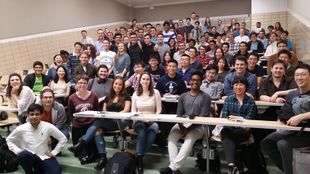1617-257/Homework Assignment 15: Difference between revisions
(Created page with "{{1617-257/Navigation}} {{In Preparation}} ==Reading== Read, reread and rereread your notes to this point, and make sure that you really, really really, really really really u...") |
No edit summary |
||
| Line 2: | Line 2: | ||
{{In Preparation}} |
{{In Preparation}} |
||
==Reading== |
==Reading== |
||
Read, reread and rereread your notes to this point, and make sure that you really, really really, really really really understand everything in them. Do the same every week! Also, read, reread and rereread sections |
Read, reread and rereread your notes to this point, and make sure that you really, really really, really really really understand everything in them. Do the same every week! Also, read, reread and rereread sections 29-31 of Munkres' book to the same standard of understanding. Remember that reading math isn't like reading a novel! If you read a novel and miss a few details most likely you'll still understand the novel. But if you miss a few details in a math text, often you'll miss everything that follows. So reading math takes reading and rereading and rerereading and a lot of thought about what you've read. Also, preread section 33, just to get a feel for the future. |
||
==Doing== |
==Doing== |
||
'''Solve''' ''all'' the problems in sections |
'''Solve''' ''all'' the problems in sections 29 and 30, but submit only your solutions of problem <u>1</u>, <u>2</u>, and <u>4</u> in section 29 and problems <u>2</u> and <u>4</u> in section 30. |
||
'''<u>Problem A.</u>''' Along the lines of our development of a theory of "tensors" and a theory of "alternating tensors", develop a theory of "symmetric tensors" <math>S^k(V)</math> (a symmetric tensor is a tensor whose values are unchanged if its arguments are permuted). Your theory should include definitions for specific tensors <math>\sigma_I</math> for <math>I\in\underline{n}^k_s</math> (what should <math>\underline{n}^k_s</math> be)?), a proof that the <math>\sigma_I</math> exist and are unique and that they form a basis of <math>S^k(V)</math>, and a computation of the dimension of <math>S^k(V)</math>. |
|||
'''<u>Problem B.</u>''' Find a good way of identifying <math>A^1({\mathbb R}^3)</math> and <math>A^2({\mathbb R}^3)</math> with <math>{\mathbb R}^3</math>. Under that identification, <math>\wedge\colon A^1({\mathbb R}^3)\times A^1({\mathbb R}^3)\to A^2({\mathbb R}^3)</math> becomes a map <math>P\colon{\mathbb R}^3\times{\mathbb R}^3\to{\mathbb R}^3</math>. If you chose your identifications right, <math>P</math> is the vector product of two vectors in <math>{\mathbb R}^3</math>. See to it that this is the indeed the case! |
|||
'''Problem C.''' The determinant, as a function of a list of column vectors, is alternating. Write it in terms of the elementary alternating functions <math>\psi_I</math>. |
|||
==Submission== |
==Submission== |
||
Here and everywhere, '''neatness counts!!''' You may be brilliant and you may mean just the right things, but if the teaching assistants will be having hard time deciphering your work they will give up and assume it is wrong. |
Here and everywhere, '''neatness counts!!''' You may be brilliant and you may mean just the right things, but if the teaching assistants will be having hard time deciphering your work they will give up and assume it is wrong. |
||
This assignment is due in class on <span style="color: blue;">Wednesday |
This assignment is due in class on <span style="color: blue;">Wednesday March 1 by 2:10PM</span>. |
||
===<span style="color: red;">Important</span>=== |
===<span style="color: red;">Important</span>=== |
||
Revision as of 11:53, 13 February 2017
The information below is preliminary and cannot be trusted! (v)
Reading
Read, reread and rereread your notes to this point, and make sure that you really, really really, really really really understand everything in them. Do the same every week! Also, read, reread and rereread sections 29-31 of Munkres' book to the same standard of understanding. Remember that reading math isn't like reading a novel! If you read a novel and miss a few details most likely you'll still understand the novel. But if you miss a few details in a math text, often you'll miss everything that follows. So reading math takes reading and rereading and rerereading and a lot of thought about what you've read. Also, preread section 33, just to get a feel for the future.
Doing
Solve all the problems in sections 29 and 30, but submit only your solutions of problem 1, 2, and 4 in section 29 and problems 2 and 4 in section 30.
Submission
Here and everywhere, neatness counts!! You may be brilliant and you may mean just the right things, but if the teaching assistants will be having hard time deciphering your work they will give up and assume it is wrong.
This assignment is due in class on Wednesday March 1 by 2:10PM.
Important
Please write on your assignment the day of the tutorial when you'd like to pick it up once it is marked (Wednesday or Thursday).

